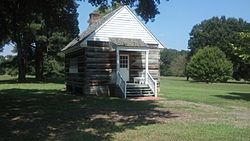Cherokee Phoenix facts for kids

Front page of the Cherokee Phoenix 1828
|
|
| Owner(s) | Cherokee Nation |
|---|---|
| Founded | 1828 |
| Language | Cherokee and English |
| Headquarters | Cherokee Nation Tribal Complex Tsa-La-Gi Annex Room 231 Tahlequah, Oklahoma |
| OCLC number | 53811290 |
The Cherokee Phoenix (ᏣᎳᎩ ᏧᎴᎯᏌᏅᎯ, pronounced Tsalagi Tsulehisanvhi) is a very important newspaper. It was the first newspaper ever published by Native Americans in the United States. It was also the first newspaper printed in a Native American language.
The first issue came out on February 21, 1828. It was printed in both English and Cherokee. This happened in New Echota, which was the capital of the Cherokee Nation. Today, New Echota is in Georgia. The newspaper was published until 1834. The Cherokee Phoenix was started again later. Today, you can read it in print and online.
Contents
The Cherokee Phoenix Newspaper
Starting a Newspaper
In the 1820s, the Cherokee tribe faced big challenges. The government, especially Georgia, wanted them to move. They were pressured to leave their lands and move west of the Mississippi River. Another option was to give up their tribal government.
To deal with this, the Cherokee Nation's leaders decided to start a newspaper. They worked with Samuel Worcester, a missionary. He helped create the special letters for the Cherokee language. The leaders chose Elias Boudinot to be the first editor.
Elias Boudinot was born in 1804. His Cherokee name was Galagina Oowatie. He chose the name Elias Boudinot after meeting a famous statesman. This happened when he was going to school in Connecticut. He later married Harriet Ruggles Gold and they lived in New Echota.
A Voice for the Cherokee Nation
Boudinot named the newspaper Cherokee Phoenix. The phoenix is a mythical bird that rises from ashes. This name showed hope for new life and strength. The Cherokee Nation wanted the paper to unite its members. They also wanted to keep everyone informed.
The newspaper was printed in both English and Cherokee. It used the Cherokee syllabary, which was invented by Sequoyah in 1821. People who could only read Cherokee got the paper for free. Those who read English paid a small fee.
The Cherokee Phoenix was the main way to share news. It connected many Cherokee towns. The Cherokee Nation once covered parts of what are now Virginia, North Carolina, Alabama, and Georgia.
The first issue came out on February 21, 1828. It had four pages. The editor said that translating between English and Cherokee took time. So, at first, only some parts would be in Cherokee. The first issue had many topics. Samuel Worcester wrote about Sequoyah's amazing invention. Boudinot's first editorial criticized white settlers. These settlers wanted Cherokee land.
As the idea of moving Native Americans gained attention, the newspaper went on a tour. This tour helped raise money and get new readers. People from across the US and Europe subscribed. Boudinot started printing more in English. He wanted to reach a larger audience.
Challenges and Changes
In 1829, Boudinot changed the paper's name. It became the Cherokee Phoenix and Indians' Advocate. This showed he wanted to help all Native Americans. He wrote about issues facing tribes across the United States. These issues included fitting into American society or being forced to move. The paper was no longer just about the Cherokee tribe. It also shared news about debates over Native American removal. It covered US Supreme Court cases that affected Native American life.
Boudinot believed that moving was unavoidable. He thought the Cherokee should protect their rights through treaties. He agreed with Major Ridge on this idea. However, most Cherokee people disagreed with him. This included Principal Chief John Ross. Ross was elected in 1828.
People who were once Boudinot's friends in the government turned against him. They questioned his loyalty. They stopped him from speaking in meetings. Chief Ross did not like that Boudinot allowed different ideas in the Cherokee Phoenix. Ross told Boudinot not to discuss arguments for moving. Because of this, Boudinot resigned in the spring of 1832. Ross's brother-in-law, Elijah Hicks, became the new editor.
Elijah Hicks was against the Cherokee moving. He took over as editor. In 1834, the federal government did not pay money owed to the Cherokee. Because of this, the newspaper stopped publishing. In August 1835, a group called the Georgia Guard took the printing press. They wanted to stop the paper from being published. They also wanted to prevent it from being influenced by John Ross. This state group was set up to control the Cherokee land that Georgia claimed.
The Phoenix Rises Again
Modern Day Cherokee Phoenix
The Cherokee Phoenix was published sometimes after the Cherokee moved to Indian Territory. In recent times, it has been brought back to life. Today, the Cherokee Nation publishes it monthly. It is printed in Tahlequah, Oklahoma.
The newspaper has become modern. You can read it online, as well as in print. You can find old versions of the paper online. The University of Georgia libraries have a digital version. You can also find English parts of the 19th-century newspaper. These are on the Western Carolina University's Hunter Library website.
In 2013, artists Jeff Marley and Frank Brannon did something special. They printed using Cherokee syllabary type. This happened at the print shop in New Echota. It was the first time syllabary printing type was used there since 1835.



